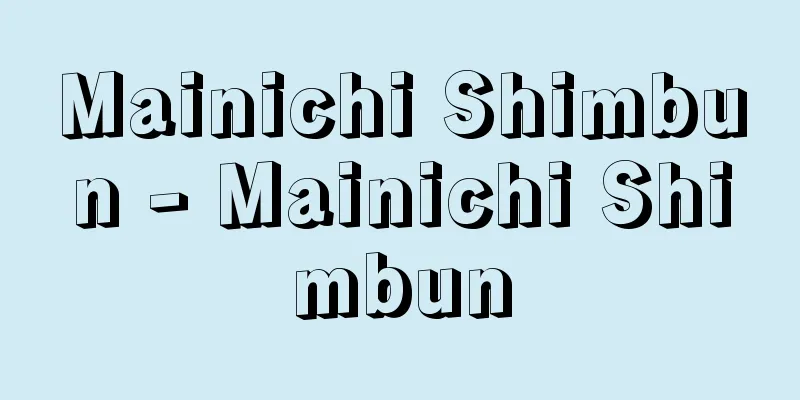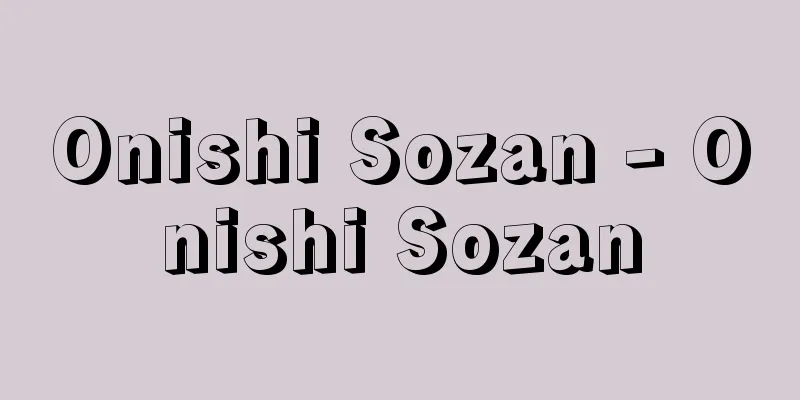Mainichi Shimbun - Mainichi Shimbun

|
One of Japan's leading national newspapers. Meiji PeriodIts predecessor was the Nippon Rikken Seito Shinbun, which was founded on February 1, 1882 (Meiji 15) by purchasing the Osaka Nippo (founded in 1876), but due to government suppression of freedom of speech it severed its ties with the Liberal Party and was restored to the name Osaka Nippo in September 1885. In 1887, Osaka businessman Kanematsu Fusajiro took it over, and on November 20, 1888, it was renamed the Osaka Mainichi Shinbun and published as the official newspaper of Osaka's business community, and in April of the following year Motoyama Hikoichi, manager of the Fujita Group, became involved in management as an advisor, laying the foundation for its development. During the Sino-Japanese and Russo-Japanese Wars, the newspaper was one of the first to send war correspondents and competed with the Osaka Asahi Shimbun for breaking news. Sales chief Kirihara Sutezo, who joined the company in 1899, implemented an active promotion policy that helped the newspaper expand its sales, and by the turn of the 20th century, the newspaper had solidified its position as a rival to the Osaka Asahi Shimbun. During this time, Hara Takashi joined the company in September 1897, and Komatsubara Eitaro in 1900 (Meiji 33), and served as editor-in-chief and then president, enhancing the newspaper's reputation. Hara in particular was the first to set up an overseas communication network, and was highly praised for his proactive policies, such as publishing a separate "Kyoto supplement" (a pioneer of local editions), restricting the use of Chinese characters, and advocating reforms to writing style. Motoyama, who became president in 1903, further planned to expand into Tokyo, and on December 21, 1906, he acquired the Denpo Shimbun and renamed it Mainichi Denpo. On March 1, 1911, he acquired Tokyo's oldest daily newspaper, the Tokyo Nichi Nichi Shimbun (merging with the Mainichi Denpo), and began managing it. This completed the company's expansion into Tokyo, establishing a foothold as a national newspaper and significantly strengthening its communication functions. [Akihiko Sunohara] Taisho periodIn the Taisho era, the newspaper signed a sales agreement with the Osaka Asahi Shimbun, expanding into the provinces and beginning to publish an evening edition on October 10, 1915 (Taisho 4). It also dispatched correspondents to Europe and the US, and on December 15, 1923, it formally concluded a special agreement with the American UP Press Agency, with which it had a long-standing cooperative relationship, steadily enhancing its communication network. The Tokyo Nichi Nichi Shimbun escaped damage in the Great Kanto Earthquake on September 1, 1923, and doubled its circulation to begin publishing an evening edition on the 18th of that month, while the Osaka Mainichi Shimbun also surpassed one million copies by New Year's Day in 1924. [Akihiko Sunohara] Showa PeriodEntering the Showa era, the newspaper began printing and publishing in Moji in February 1935 (Showa 10) and Nagoya in November (suspended in 1942). In December, it absorbed the traditional Jiji Shimpo into the Tokyo Nichi Nichi Shimbun and continued to grow, unifying the East and West titles into the Mainichi Shimbun in January 1943. During and after World War II, the newspaper temporarily suspended its evening edition due to paper shortages, but in the 1950s, the paper situation improved and the newspaper revived the evening edition (December 1949) and resumed printing in Nagoya, expanding its sales channels with the reinstatement of the monopoly system. It began printing and publishing in Sapporo in May 1959 (Showa 34), and circulation increased, surpassing 5 million copies by the beginning of 1970. In terms of reporting, the newspaper had shown strength in Asian reporting even before World War II, and in 1965, during the Vietnam War, it attracted attention with its remarkable reporting, such as the serialization of "Indochina in Mud and Fire" and the fact that foreign news chief Omori Minoru was one of the first to enter Hanoi during the US air raids. When Okinawa was returned to Japan in 1972, the newspaper reported a number of scoops, including exposing a secret agreement between Japan and the US (the Okinawa Secret Agreement Exposure Incident), and in 1981, eliciting comments from former US Ambassador to Japan Reischauer on the issue of allowing nuclear weapons to be brought to the mainland. However, during that time, the oil crisis (1973) and other factors caused the newspaper's financial situation to deteriorate, so in 1977 it created a new company and made a fresh start, promoting itself as an "open newspaper." [Akihiko Sunohara] Heisei PeriodIn the late 1980s, the company recovered from its management crisis, and in the Heisei era, it computerized all page production and, under the slogan of the "newspaper revolution," it has been working on ambitious page reforms and innovative projects, such as making the pages wider and more visual. In the fall of 2000, it also pioneered the industry by establishing the "Open Newspaper Committee," demonstrating its proactive approach to responding to the needs of its readers. The company is also enthusiastic about tackling environmental issues, and in 1996 it renamed its "Science Club" to the "Science and Environment Club," and in 2007 launched the "MOTTAINAI" campaign to emphasize the importance of resources, drawing attention for its commitment to promoting the "Environment Every Day" initiative. It has also actively expanded into the digital media business, launching a website in 1995 ahead of other companies, and since 2010 has provided " Mainichi iTimes ," a special edition of Mainichi Shimbun news, through a digital distribution company, and launched the digital photography magazine " photoJ ." The editorial activities are active, including campaigns and scoops, and the layout of the paper is highly praised, and the paper has won many of the most prestigious awards in the newspaper industry, such as the Newspaper Association Award, the Kikuchi Kan Award, the Vaughn-Ueda Award, and the Japan National Press Club Award. It also has a complete overseas reporting network, and as of 2011 it has four bureaus in Asia (Bangkok), China (Beijing), North America (Washington), and Europe (London), and 20 branches around the world, and has special agreements with AP (USA), Reuters (UK), and the Korea News Agency. In Japan, it rejoined the Kyodo News Agency in April 2010 (it left along with Asahi and Yomiuri in 1952), and since then has signed contracts with major local newspapers one after another to distribute articles and photos, streamlining its reporting organization and improving its local pages, aiming to become a national newspaper for the new era. The circulation is approximately 3.62 million copies for the morning edition and 1.24 million copies for the evening edition (2010), and it has publishing offices in Tokyo, Osaka, Kitakyushu, Nagoya, and Sapporo. [Akihiko Sunohara] "History of the Osaka Mainichi Shimbun Company," by Ono Hideo (1925, Osaka Mainichi Shimbun)" ▽ "Fifty Years of the Osaka Mainichi Shimbun, edited by Osaka Mainichi Shimbun (1932, Osaka Mainichi Shimbun)" ▽ "Seventy Years of the Tohnichi Shimbun History" (1941, Tokyo Nichi Nichi Shimbun and Osaka Mainichi Shimbun)" ▽ "History of the Mainichi Shimbun Western Headquarters," by Yamaji Teizo (1948, Mainichi Shimbun Western Headquarters)" ▽ "Seventy Years of the Mainichi Shimbun, edited by the Corporate History Compilation Committee (1952, Mainichi Shimbun)" ▽ "Centennial History of the Mainichi Shimbun, edited by the Mainichi Shimbun Centennial History Publication Committee (1972, Mainichi Shimbun)" ▽ "History of the Mainichi Shimbun Sales: Prewar and Osaka Edition," edited by Kawakami Tomizo (1979, Mainichi Shimbun Osaka Development Co., Ltd.)" ▽ "Three Centuries of the Mainichi Shimbun: 130 Years of Turmoil Witnessed by the Newspaper, two volumes and a supplementary set (2002)" [References] | | | | | | | Shimbun | Hara | |Source: Shogakukan Encyclopedia Nipponica About Encyclopedia Nipponica Information | Legend |
|
日本の代表的な全国紙の一つ。 明治期前身は1882年(明治15)2月1日『大阪日報』(1876年創刊)を買収して創刊された『日本立憲政党新聞』だが、政府の言論弾圧を受けたため、自由党との関係を断ち、1885年9月『大阪日報』に復旧した。1887年、大阪の実業家兼松房治郎(かねまつふさじろう)がこれを譲り受け、1888年11月20日『大阪毎日新聞』と改題、大阪実業界の機関新聞として発行することになり、翌年4月、藤田組支配人の本山彦一(ひこいち)が相談役として経営に関与、発展の基礎を築いた。日清(にっしん)、日露の両戦役では、いち早く従軍記者を派遣して『大阪朝日新聞』と速報を競ったほか、1899年入社した営業主任桐原捨三(きりはらすてぞう)の積極的人気政策で販売部数を拡張、20世紀に入ると『大阪朝日新聞』に拮抗(きっこう)する地位を固めるに至った。この間、1897年9月に原敬(たかし)、1900年(明治33)には小松原英太郎(えいたろう)らが入社、編集総理、ついで社長を務め声価を高めた。とくに原は、初めて海外通信網を設置したほか、別刷りの「京都付録」(地方版の先駆)の発行、漢字制限、文体の改革を提唱するなど積極的諸施策をとり、世評を博した。 1903年社長に就任した本山は、さらに東京進出を企て、1906年12月21日『電報新聞』を買収して『毎日電報』と改題発行したが、1911年3月1日には、東京最古の日刊紙『東京日日新聞』を買収(『毎日電報』を合併)経営することになり、東京進出は完成、全国紙としての地歩を確立するとともに、通信機能が著しく強化された。 [春原昭彦] 大正期大正に入ると『大阪朝日新聞』と販売協定を結び、地方へ進出するとともに、1915年(大正4)10月10日から夕刊を発行した。また、欧米に常駐特派員を派遣、1923年12月15日には、かねてから協力関係にあったアメリカのUP通信社と正式に特約を締結するなど、着々と通信網を充実していった。同1923年9月1日の関東大震災でも『東京日日新聞』は被災を免れ、部数を倍増して同月18日から夕刊を発行、『大阪毎日新聞』も翌1924年の元日部数で100万部を突破した。 [春原昭彦] 昭和期昭和に入り、1935年(昭和10)2月に門司(もじ)、11月に名古屋で印刷発行を開始(1942年休止)、12月には、伝統ある『時事新報』を『東京日日新聞』に吸収して発展を続け、1943年1月から東西の題号を『毎日新聞』に統一した。第二次世界大戦中から戦後にかけて、用紙難で一時夕刊を休止したが、1950年代に入ると用紙事情も好転、夕刊を復活(1949年12月)するとともに名古屋での印刷を再開し、専売制復活とともに販路を拡張する。1959年(昭和34)5月から札幌で印刷発行を開始するなど部数を伸ばし、1970年初頭には500万部を突破した。報道面では、第二次世界大戦前からアジア報道に強みをみせていたが、ベトナム戦争中の1965年には「泥と炎のインドシナ」を連載、米軍空爆下のハノイに外信部長大森実がいち早く乗り込むなど目覚ましい報道で注目を集めた。1972年の沖縄返還に際しては、日米の密約を暴露(沖縄密約暴露事件)、1981年には本土への核持ち込み容認問題で、ライシャワー元駐日アメリカ大使の発言を引き出すなど数々のスクープを報じている。しかしその間、石油危機(1973)などもあって経営内容が悪化したため、1977年新会社をつくり、「開かれた新聞」をうたって再出発した。 [春原昭彦] 平成期1980年代後半になって経営も危機を脱し、平成になると全紙面製作をコンピュータ化するとともに、「新聞革命」のスローガンのもと、紙面のワイド化、ビジュアル化など、意欲的な紙面改革、斬新(ざんしん)な企画に取り組んでいる。また、2000年(平成12)秋には、業界に先駆けて「『開かれた新聞』委員会」をつくり、読者の訴えに積極的にこたえる姿勢を示している。 環境問題への取り組みにも熱心で、1996年「科学部」を「科学環境部」に改称、2007年には資源の大切さを訴える「MOTTAINAI」キャンペーンを展開するなど、「環境の毎日」推進事業に取り組む姿勢は注目されている。デジタル・メディア事業にも積極的に進出、1995年には他社に先駆けてウェブサイトを立ち上げ、2010年からはデジタル配信会社を通じ、毎日新聞のニュースを特別編集した『Mainichi iTimes(マイニチアイタイムズ)』を提供、デジタル写真雑誌『photoJ.(フォトジェイドット)』を創刊するなどしている。 編集活動は、キャンペーン、スクープなど活発で、その紙面づくりは高く評価され、新聞協会賞、菊池寛賞、ボーン・上田賞、日本記者クラブ賞など新聞界でもっとも権威ある賞を多く受賞している。海外取材網も完備し、2011年時点で、アジア(バンコク)、中国(北京(ペキン))、北米(ワシントン)、欧州(ロンドン)の4総局、世界各地に20支局を設置、AP(アメリカ)、ロイター(イギリス)、朝鮮通信などと特約を結んでいる。国内でも2010年4月に、共同通信社に再加盟(1952年に朝日、読売両社とともに脱退)、以後有力地方紙とも次々に記事や写真の配信契約を結び、取材組織の合理化とともに地域面の充実を図り、新しい時代の全国紙を目ざしている。発行部数は朝刊約362万部、夕刊約124万部(2010)で、東京と大阪のほか、北九州、名古屋、札幌の各市に発行所をもっている。 [春原昭彦] 『小野秀雄著『大阪毎日新聞社史』(1925・大阪毎日新聞社)』▽『大阪毎日新聞社編『大阪毎日新聞五十年』(1932・大阪毎日新聞社)』▽『『東日七十年史』(1941・東京日日新聞社・大阪毎日新聞社)』▽『山路貞三著『毎日新聞西部本社史』(1948・毎日新聞西部本社)』▽『社史編纂委員会編『毎日新聞七十年』(1952・毎日新聞社)』▽『毎日新聞百年史刊行委員会編『毎日新聞百年史』(1972・毎日新聞社)』▽『川上富蔵編著『毎日新聞販売史 戦前・大阪編』(1979・毎日新聞大阪開発株式会社)』▽『毎日新聞社編・刊『「毎日」の3世紀――新聞が見つめた激流130年』上下・別巻(2002)』 [参照項目] | | | | | | | | | |出典 小学館 日本大百科全書(ニッポニカ)日本大百科全書(ニッポニカ)について 情報 | 凡例 |
<<: Mainichi Broadcasting System Co., Ltd. - Mainichi Broadcasting
Recommend
Obrock - Obrock
...serfs could be freely sold, given away, mortga...
Hume pipe
A reinforced concrete pipe that uses centrifugal ...
Sycamore
…The sap of the black maple also contains 1.3 to ...
Petrozavodsk (English spelling) Петрозаводск/Petrozavodsk
The capital of the Republic of Karelia in the nor...
Yamaga [town] - Yamaga
This old town occupies the right bank of the upper...
Ando Tsuguaki
1747-1793 A samurai from the mid to late Edo peri...
Siberian snail - Siberian snail
...They are distributed from Hokkaido to Kyushu (...
Hui people's restaurant - Kaimin Shokudo
... The number of restaurants in the city, from h...
Sebenico
…A port town in the Dalmatia region in the south ...
Eṭṭutokai (English spelling)
… [Masayuki Onishi] [Tamil Literature] The Dravid...
Louisiana [State] - Louisiana
A state in the southern United States, on the Gulf...
Peltoboykinia
…A perennial herb of the Saxifragaceae family tha...
Columbus - Christopher Columbus
His Spanish name was Cristobal Colón, and his Ita...
Broken Hill Proprietary Co., Ltd.
Australia's largest integrated steel manufactu...
Amatsu Otome
Actress. Her real name was Eiko Torii. In 1918 (T...









